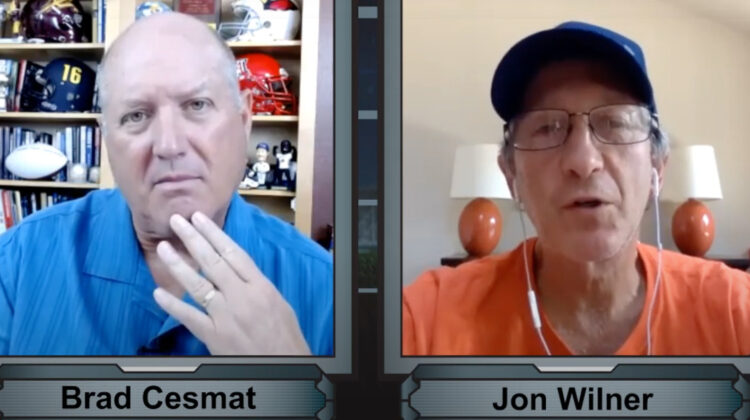The Hotline mailbag is published every Friday. Send questions to pac12hotline@bayareanewsgroup.com and include ‘mailbag’ in the subject line — or hit me on Twitter: @WilnerHotline.
Please note: Several topics related to Pac-12 media rights and expansion will be answered separately, in forthcoming articles.
Some questions have been edited for clarity and brevity.
What’s the deal with Fox? — @Buffaloakk
Good question: What is the deal with Fox?
This week alone, there have been varying reports about Fox’s involvement in the Pac-12 media negotiations — none of them mutually exclusive: Fox can be interested in a package of Pac-12 games but not actively involved at this point.
The situation reflects just how nuanced media negotiations can be and just how secretive the Pac-12’s process has been.
Our view hasn’t changed: Fox has a lot of Saturday night broadcast windows on FS1 that are currently devoted to Pac-12 content and must be filled in the next contract cycle.
Sure, it could slot Mountain West matchups and Brigham Young home games into that window. But the network assuredly would want the option for Pac-12 games (at the right price, of course).
That said, there is no indication Fox wants a significant portion of Pac-12 inventory — that it will, or has, bid on the Tier 1 (premium) games.
Those negotiations likely involve ESPN, Apple and Amazon.
More broadly, Fox has played a crucial role in moving the situation to this point.
As most fans are aware, the network orchestrated the Big Ten’s raid of USC and UCLA, according to … well, according to every media industry source we have. (One sarcastically referred to the Big Ten as “Fox Inc.”)
It also has impacted the course of events for the Pac-12 relative to the Big 12, with a massive advantage to the latter.
Why? Fox has a longstanding contractual relationship with both conferences. In the case of the Big 12, Fox lost the premier brands when Texas and Oklahoma bolted for the SEC, which has an all-in contract with ESPN.
As a result, Fox needed Big 12 inventory to retain a presence in Texas.
With the Pac-12, the situation is reversed. Whereas Texas and Oklahoma went away from a conference aligned with Fox, the L.A. schools jumped into a Fox conference.
Because of its broadcast partnership with the Big Ten, the network can maintain its presence in the massive Southern California media market. It kept what it wanted, in other words, and has little motivation to maintain a major stake in the Pac-12.
It had to partner with the Big 12 to keep a foothold in Teas.
It doesn’t have to partner with the Pac-12 to keep its flag in California.
So in some respects, Fox bludgeoned the Pac-12 twice.
Which brings us to another issue the Hotline has pondered for months.
The Pac-12’s current contracts with Fox and ESPN gave the networks a 90-day exclusive negotiating window with the conference to hash out a new media deal.
We know that window opened in July and closed in early October.
We also know that the Pac-12 was unable to extricate itself from that window until the 90 days ended.
And we can assume that Fox, because it already had what it wanted — the L.A. market — did not make a serious offer for Pac-12 inventory.
Three weeks after the Pac-12’s exclusive negotiating window ended, the Big 12 announced an early renewal of its agreement with Fox and ESPN.
We would love to know the details of conversations between Pac-12 commissioner George Kliavkoff and the Fox executives.
Unfortunately, that aspect of the saga likely will remain a mystery forever.
Following up to a good past article, you projected a $6 million gap (per school) between the Pac-12 and Big 12 distributions for the 2023 fiscal year. For 2025 and beyond, what are your projections? Do you see a continued $6 million or more gap? — @vakaviti
Yes, the Big 12 has already been distributing more cash to its schools than the Pac-12 — a point that many have missed during this saga.
The Big 12’s regular-season broadcast contracts with ESPN and Fox spin off more money than the Pac-12 deals, and the Big 12’s total revenue for each school, which includes NCAA Tournament and the football postseason, is greater, as well.
But it’s too early to estimate the differences in the next contract cycle.
Once we see the Pac-12’s media rights deal, and whether there is unequal sharing of postseason revenue — that would be a smart move on several fronts, by the way — the Hotline will offer new projections.
Would the Pac-12 ever consider a Friday night doubleheader and just own that space? Including non-conference games, it would require two or three games per team (assuming 12 members), so it’s a big commitment. — @Smittytheclownn
Probably too big, in our opinion.
The Friday night window has value, and it would certainly have value to Amazon coming out of the ‘Thursday Night Football’ broadcast.
But even if we ignore the non-conference piece and simply focus on league play, a Friday doubleheader over at least nine weeks would mean 18 games — 18 out of the 54.
That’s a huge percentage, especially given that Friday nights aren’t necessarily easy for fans or the campuses.
We suspect the media deal will include a Friday package of games, but only one each week — and maybe just six or eight through the course of the season.
Could it be possible to move Pac-12 Network content to whichever streamer gets the rights starting next year and not wait? — @CoachMorrowosu
I don’t see how that’s possible given the contracts.
The Pac-12 created a coterminous situation: The distribution deals with Fox, ESPN and the Pac-12 Network’s partners (Comcast, DISH, etc.) all expire at the same time, in the summer of 2024.
It’s a smart strategy — one of the few things former commissioner Larry Scott got right on the media front — but our sense is the deals are unbreakable unless the partners agree. And there’s no sign of that.
If Big 12 commissioner Brett Yormark wants his conference coast-to-coast, the Pac-12 wants to stay together and no one wants to be left out in the cold, why can’t everyone drop their swords and merge into the BigPac and get on with life? — @HazzardCoEng
The Hotline advocated years ago for the Pac-12 and Big 12 to create a partnership and argued again for that strategy last summer.
It would have enhanced media value, created a coast-to-coast product and strengthened both conferences against defections by the top brands.
But at this point, the chances of a partnership or merger are microscopic.
Dollars and egos always trump common sense.
Remember years ago how conferences implemented big exit fees to keep teams from defecting? What does that mean for the defections of USC and UCLA and possible additions of San Diego State and SMU? — Doug Ware
To the best of our knowledge, USC and UCLA are not paying any exit fees. Their departure tracks with the end of the Pac-12’s current media rights agreement, so they won’t face a financial penalty.
My assumption is that any new members would have to agree to the terms of the next contract.
What those terms are, we cannot say. But it’s safe to assume exit fees and penalties are part of the ongoing discussion at the presidential level.
If SMU and/or San Diego State join the Pac-12, do they get the money from UCLA’s NCAA tournament run this year? — @lilcmac5
That will be sorted out in the negotiations, and we can offer a morsel of insight momentarily.
First, let’s make sure all readers understand how the March Madness revenue generated by UCLA and USC will be handled.
Each game played equals one unit in the NCAA’s distribution formula. The units are carried forward for six years and have a dollar value that increases annually (this year: $350,000).
The single unit earned by USC and the three units earned by UCLA this month will generate revenue for the Pac-12 starting next spring.
The Pac-12’s business model calls for an equal sharing of all NCAA revenue, but the Bruins and Trojans won’t keep their shares once they enter the Big Ten in the summer of 2024. That cash will remain with the conference, divided among the membership.
Any new members would have to negotiate terms of inclusion, with revenue splits undoubtedly atop the list of issues.
Neither SMU nor San Diego State would receive a full share, but would they be given half-shares or quarter-shares?
And would their splits increase over the course of the media contract?
That is all very much to be determined.
Is there a scenario where some of the second-level Pac-12 football rivalries might survive in some limited fashion, or are the remaining schools more likely to decline any future games with USC and UCLA? — John Vietor
I suspect the California schools will schedule each other. The Bay Area teams need ticket-selling opportunities, and the L.A. teams need non-conference games with limited travel.
But every school, from Tucson to Pullman, should attempt to schedule the Trojans and Bruins.
It will become increasingly difficult to get premier matchups, especially with Big Ten teams reluctant to make non-conference trips to the West Coast and with Brigham Young’s availability limited by its move into the Big 12.
In some ways, the L.A. schools will become the new BYU, times two.
Is it frustrating for you to report sourced information about the Pac-12 media negotiations only to have national media people report conflicting information? — @NewsManLou
Very few people are aware of the details of the negotiations; the conference has kept the circle extremely tight.
As a result, the Hotline has taken great care to distinguish between facts (sourced reporting) and opinion (our best guesses, so to speak).
I am not aware of a specific instance in which the Hotline has reported something as fact, only to have it refuted by a national media outlet.
Anytime the Hotline publishes opinion pieces or attempts to forecast events, it’s done with the understanding that we could be proven incorrect.
That said, for the past eight months, we have maintained the following:
— Pac-12 survival is the most likely outcome but not guaranteed.
— Pac-12 expansion is more likely than moving forward as a 10-school conference.
— The Big Ten door is closed, likely through the remainder of the decade.
— The Four Corners schools would prefer to remain in the Pac-12 than move to the Big 12.
— The Pac-12 and Big 12 media valuations are similar; neither offers a transformational advantage.
We believe each aspect of that framework remains in place.
You said back in February that every week after mid-March of the Pac-12 not having a media deal in place drops the survival odds by half a point. Knowing what you do now, do you still hold to this belief? — @SoCal_Pony
Our general view is the following:
When it comes to realignment, time and security move inversely: The longer a media rights deal takes to complete, the greater the likelihood of an unexpected occurrence — and unexpected occurrences are rarely beneficial.
Our odds for Pac-12 survival have dropped to 4.5 points (from 5.5), which should come as no surprise to anyone who read our early-March predictions.
We opted against setting the line a half-point lower — at least for the moment — because of the public comments from several presidents over the past two weeks.
If the situation appeared truly dire behind the scenes, the conference, which has been incredibly disciplined in its messaging, would not have sent them out with talking points.
Could commissioner George Kliavkoff have misread the state of the negotiations, leaving the conference exposed to a massive downside surprise and, potentially, extinction?
That scenario seems unlikely but, once again, cannot be ignored until a contract is approved.
I agree that there is zero chance the presidents would have expressed solidarity and optimism unless they were getting positive updates from Kliavkoff. But what level of detail do you suppose they’re actually getting? — @bdbigelow89
Based on comments made by Arizona’s Robert Robbins, the presidents hadn’t seen final offers as of early last week.
Could more details have been provided at the Pac-12 meeting on Wednesday? Of course. But we would caution readers to keep in mind that an offer and a signed contract are very different things.
In fact, the biggest obstacles might be the details, not the dollars.
The schools are keenly interested in how much content would be on linear and streaming platforms, the number of night football games and the in-season selection process.
That final piece is critical: If the kickoff times are set well in advance, fans can make plans to attend and schools can develop marketing strategies, thereby increasing gate revenue and potentially offsetting a slightly lower dollar figure (from the media rights contract) than desired.
Do not underestimate how much the schools value an enhanced game-day experience — and the role that issue is playing in the negotiations.
What alcoholic beverage is best, beer or wine? — @KoolEconomics
The Hotline hasn’t taken a sip of alcohol in years. And we never, ever liked wine.
It tastes even worse than Pepsi.
*** Send suggestions, comments and tips (confidentiality guaranteed) to pac12hotline@bayareanewsgroup.com or call 408-920-5716
*** Follow me on Twitter: @WilnerHotline
*** Pac-12 Hotline is not endorsed or sponsored by the Pac-12 Conference, and the views expressed herein do not necessarily reflect the views of the Conference.
Related posts:
 Wilner Hotline – Pac-12 on the brink: USC and UCLA expected to seek membership in the Big Ten
Wilner Hotline – Pac-12 on the brink: USC and UCLA expected to seek membership in the Big Ten  Pac-12 survival: What to make of Big Ten expansion plans, Oregon’s search for an escape hatch and the Big 12 option
Pac-12 survival: What to make of Big Ten expansion plans, Oregon’s search for an escape hatch and the Big 12 option  Pac-12 survival: Why the conference should follow the CFP’s lead and expand
Pac-12 survival: Why the conference should follow the CFP’s lead and expand 
Washington State quarterback Cameron Ward (1) (AP Photo/Andy Manis)
Wilner Hotline – Saturday Night Five: Along come the Cougars, OSU’s big win, USC’s takeaways, collecting wins (except in Boulder)
